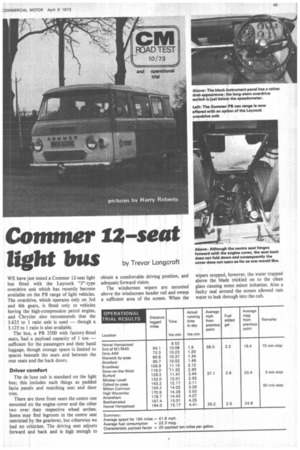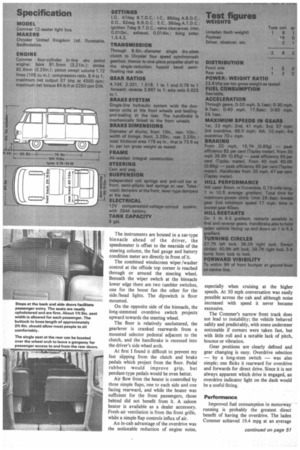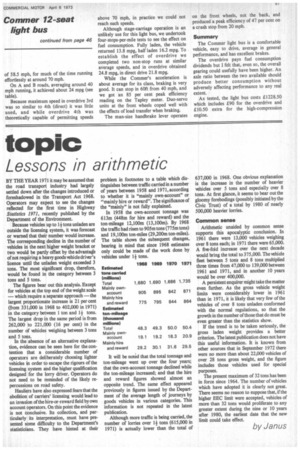Comma* 12-seat
Page 47

Page 48

Page 53

If you've noticed an error in this article please click here to report it so we can fix it.
light bus by Trevor Longcroft
WE have just tested a Commer 12-seat light bus fitted with the Laycock "J"-type overdrive unit which has recently become available on the PB range of light vehicles. The overdrive, which operates only on 3rd and 4th gears, is fitted only to vehicles having the high-compression petrol engine, and Chrysler also recommends that the 5.625 to 1 ratio axle is used though a 5.125 to 1 ratio is also available.
The bus, a PB 2500 with factory-fitted seats, had a payload capacity of 1 ton sufficient for the passengers and their hand luggage, though storage space is limited to spaces beneath the seats and between the rear seats and the back doors.
Driver comfort The de luxe cab is standard on the light bus; this includes such things as padded facia panels and matching seat and door trim.
There are three front seats the centre one mounted on the engine cover and the other two over their respective wheel arches. Some may find legroom in the centre seat restricted by the gearlever, but otherwise we had no criticism. The driving seat adjusts forward and back and is high enough to obtain a comfortable driving position, and adequate forward vision.
The windscreen wipers are mounted above the windscreen header rail and sweep a sufficient area of the screen. When the wipers stopped, however, the water trapped above the blade trickled on to the clean glass causing some minor irritation. Also a faulty seal around the screen allowed rain water to leak through into the cab.
The instruments arc housed in a car-type binnacle ahead of the driver, the speedometer is offset to the nearside of the steering column, the fuel gauge and battery condition meter are directly in front of it.
The combined windscreen wiper /washer control at the offside top corner is reached through or around the steering wheel. Beneath the wiper switch at the binnacle lower edge there are two tumbler switches, one for the boost fan the other for the side /head lights. The dipswitch is floor mounted.
On the opposite side of the binnacle, the long-stemmed overdrive switch projects upward towards the steering wheel.
The floor is relatively uncluttered, the gearlever is cranked rearwards from a mounted selector pedestal adjacent to the clutch, and the handbrake is recessed into the driver's side wheel arch.
At first I found it difficult to prevent my feet slipping from the clutch and brake pedals which project from the floor. Pedal rubbers would improve grip, but pendant-type pedals would be even better.
Air flow from the heater is controlled by three simple flaps, one to each side and one facing rearward, and while the heater was sufficient for the front passengers, those behind did not benefit from it. A saloon heater is available as a dealer accessory. Fresh-air ventilation is from the front grille, while a simple flap controls influx of air.
An in-cab advantage of the overdrive was the noticeable reduction of engine noise,
especially when cruising at the higher speeds. At 50 mph conversation was easily possible across the cab and although noise increased with speed it never became excessive.
The Commer's narrow front track does not lead to instability; the vehicle behaved safely and predictably, with some understeer noticeable if corners were taken fast, but with little roll and a notable lack of pitch, bounce or vibration.
Gear positions are clearly defined and gear changing is easy. Overdrive selection — by a long-stem switch — was also simple; one flicks it rearward for overdrive and forwards for direct drive. Since it is not always apparent which drive is engaged, an overdrive indicator light on the dash would be a useful fitting.
Performance Improved fuel consumption in motorway running is probably the greatest direct benefit of having the overdrive. The laden Commer achieved 19.4 mpg at an average of 58.5 mph, for much of the time running effortlessly at around 70 mph.
On A and B roads, averaging around 40 mph running, it achieved about 24 mpg (see table).
Because maximum speed in overdrive 3rd was so similar to 4th (direct) it was little used, and while overdrive 4th was theoretically capable of permitting speeds above 70 mph, in practice we could not reach such speeds.
Although stage-carriage operation is an unlikely use for this light bus, we undertook four-stops-per-mile tests to see the effect on fuel consumption. Fully laden, the vehicle returned 13.8 mpg, half laden 16.2 mpg. To establish the effect of overdrive we completed two non-stop runs at similar average speeds. and in overdrive obtained 24.8 mpg, in direct drive 21.8 mpg.
While the Commer's acceleration is about average for its class, braking is very good. It can stop in 60ft from 40 mph, and we got an 85 per cent peak efficiency reading on the Tapley meter. Duo-servo units at the front wheels coped well with the effects of load transfer when braking.
The man-size handbrake lever operates on the front wheels, not the back, and produced a peak efficiency of 47 per cent on a crash stop from 20 mph.
Summary
The Commer light bus is a comfortable vehicle, easy to drive, average in general performance, and has excellent brakes.
The overdrive pays fuel consumption dividends but I felt that, even so, the overall gearing could usefully have been higher. An axle ratio between the two available should produce better consumption without adversely affecting performance to any real extent.
As tested, the light bus costs £1228.50 which includes £90 for the overdrive and £10.50 extra for the high-compression engine.












































































































